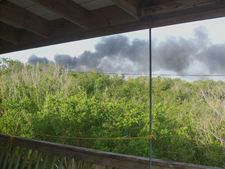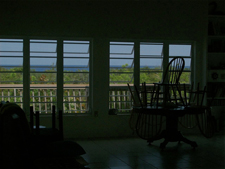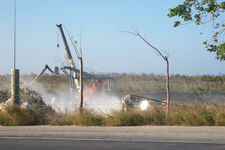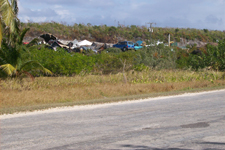The Natural House (on a natural island)
A perfect house in a perfect place. Can you imagine that happening?
These days especially.
Sure, it’s possible in a dream.
Example: A thatch hut near an idyllic beach; a small river empties into the sea there.
Example: A log cabin in the north woods, open in summer, snug and tight in winter.
Example: The wattle and daub traditional Caymanian home — local materials, set in a friendly, supportive community and surrounded by a garden. Perfection!
 |
 |
It’s still possible! A perfect house in a perfect place. A few lucky people live this way right here on Cayman Brac, TODAY. Consider!
- a strong house, a house for life, a house one can afford to build; proof against the storm;
- no water bill (the rains provide);
- no heating or cooling bills (catch the sea breeze in a perfect spot: 19N 79W);
- cool from an umbrella roof, steel tie-downs all around, “coolest house on Cayman Brac”;
- no taxes, no fees;
- modest electricity costs (how much can a small ‘fridge use, anyway?);
- no property tax or school tax;
- no swimming pool — just walk to the sea;
- hurricane-protected by the cliff (“bluff to sea” property);
- a screen of trees on all four sides (privacy and protection in the event of hurricanes);
- an open house –a natural house – jalousie window open 99 percent of the time;
- a spacious house — who needs furniture? — with a deck all ’round, at treetops level;
- peace and quiet
- high-speed internet, access to streets and roads, all services such as hospital and shops;
- set in a society that’s generally peaceful and respectful, especially of privacy.
BUT WHAT’S THE TREND LIINE?
The house and yard are as good as gold, but the community itself is somewhat in decline. Let’s try to measure that. In 2004 a questionnaire was circulated, to establish the state of the quality of natural life here — and people’s opinions about it. Let’s use its headings and see where we’re trending. Oh, this is subjective in some areas, but one can try to be as objective as possible. If we’ve gone downhill it may indicate an unhelpful attitude among government that prevents us keeping a healthy, natural community, a thriving economy and a go-ahead mood of continuous improvement. But before we lay fault on government, let’s ask: Is it us?
 |
 |
Cayman Brac Environmental Questions
Here are the criteria used to measure a healthy community, in touch with its natural surroundings thus benefiting nature (trees and creatures prosper) and benefiting all of us (clean air and other advantages). You could apply these criteria to any place in the world you may live, wish to live, or even visit:
| Air quality | better than Beijing? |
| Beach access | – |
| Beach ridge (hurricane dune) | your natural defense against the storm — a rock barrier thrown up by ancient hurricanes |
| Bluff land protection | forested areas |
| Development on CB | vs. Grand Cayman and Little Cayman |
| Energy conservation | seldom discussed, in spite of high energy costs! |
| Flies and rats | both are here in their numbers! |
| Forests | – |
| Footpaths/bicycle paths | the sign of educated communities everywhere |
| Hayman’s Pond and other places | who is protecting them? |
| Health | control of health hazards |
| Iguana protection, with habitat | think timber wolf, if you’re from the north. This is our precious equivalent |
| Industry | clean industry? Or rock quarrying? |
| Light pollution | can you see the stars? |
| Natural areas (protection) | any national parks? |
| Noise Pollution | – |
| Parks | and places for quiet recreation |
| Sewage treatment | – |
| Zoning | – |
 |
 |
Cayman Brac Environmental Report Card
With this list, you can ask “Where are we today?” or you can ask “Are we getting better or worse?” Let’s try the latter, for Cayman Brac in the Cayman Islands. What is the trend line?
| Air quality: | Getting worse. There are about five daily factors making it steadily worse; |
| Beach access: | No improvement. Nothing has been done despite promises from our top elected officials. |
| Beach ridge: | Worse. A large portion of the natural protective rock dune, just south of the Parrot Reserve, has removed. |
| Bluff land protection | No new lands protected — the opposite in fact:tree-cutting, burning and machine clearing proceeds at an ever-faster pace. We are no longer a “verdant isle”. We have lost most of our large forested area and nobody is bemoaning this loss. |
| Development | No development plan, therefore some terrible development patterns. Even worse than limestone mining is “empty bedroom community syndrome” in which wealthy people from Grand Cayman build hurricane houses on the Brac, and never use them. The land is razed, allowing Tecoma stans (“alder”) and other weed species to grow. The native trees are lost forever. On Grand Cayman, large areas have been protected by a concerted land acquisition program, especially in “the Mastic”. Little Cayman receives the same benefit — an investment in the future for native species and humans alike. The National Trust is to be commended for this program! But it has not reached Cayman Brac. Nothing has been protected here for 10 years. |
| Energy conservation | Terrible report card. It’s never discussed, let alone acted upon. The “pretty” lights at Scott’s dock represent egregious waste. |
| Flies and rats | Getting worse by the minute. At dusk in the SE corner of the island, Norway rats descend from native trees when you approach, so they can go to ground. This happens in ALL corners of the island, but this one is virtually unpopulated by man. The Norway rat is fully at home and taking space, food and almost certainly eggs from nesting native birds! |
| Forests | What forests? The road system has carved them up, the woods have been sold, now they are being burned in the “traditional” manner (oh, tradition is a good thing, right?). Land is clear – cut (usually by cheap labor but sometimes by machine) and then burned to soften the limestone. Government is as bad an offender as house builders. After the house is built (or not) the place is often abandoned to weedy bushes (so–called alder and “brown gal”). |
| Foot and bike paths | None. The west “crossover road” was kindly widened for this purpose by public/private initiative, but that’s it. To bike or jog on this island is to compete with vehicular traffic. |
| Hayman’s Pond etc. | There are many amazing places of natural beauty. A bottom-up initiative within a conservation organization seems to have ground to a halt – or has been stonewalled. Natural areas are being set aside for posterity on the other two islands, but not here. |
| Health | The only carrier of disease that is well controlled is the mosquito. Air pollution is BAD, due to dust and to uncontrolled burning of the native “bush” or forest, by both government and private action. This is a health concern for the very young, the sick and the very old, with less immediate health effects on others. The huge public dump is now a national disgrace, and a blot on our island. Suffice to say that it is very VISIBLE; it is FOUL; it BURNS regularly; it is a haven for flies and vermin; it is leaching into the Red Shrimp Hole; there is no plan to remove it (it’s a quarter-mile long, on the roadside); and it is not even discussed. Mount Trashmore on Grand Cayman is discussed, but not this one, proportionately bigger. More serious, there is no plan or DISCUSSION of a plan to reduce INPUT to the dump site, which must be Step One. |
| Iguana protection | There is a move to protect them, but so far no move to protect their habitat, which again is the obvious first step, not last step. |
| Industry | There is one “clean” company but so far no move towards financial head offices or other clean commercial development. The main revenue-producing activities are limestone quarrying and tourism, both of which carry a heavy pollutant load. |
| Light pollution | The trend line is ever worse. Ten years ago the average person could look in at least one direction (south) and see the stars clearly. Now that too has been lost. Lights penetrate into bedrooms all over the island. There is little or no regulation, control, mitigation or even discussion of this issue, which has already resulted in star-gazers taking this island off their list of places to visit, let alone live. |
| Natural areas | See forests, Hayman’s Pond and iguana protection — nothing is happening in this regard on Cayman Brac today. |
| Noise pollution | The trend line is bad. Noise is now a constant factor. To wake up at a certain hour and stand on one’s deck in perfect silence, gazing over moonlit forest, is now a rare experience. There are at least 10 noise sources and one, the new power plant on the bluff, is noisier than plant it replaces — a step backwards! Noise from the new plant radiates outwards for three miles, spoiling six miles for occupancy. “Natural houses” such as our ancestors built, cooled by the prevailing winds, are no longer suitable within HALF of our small island’s area! |
| Parks, quiet places | West End Community Park is a model! There’s a winding path through the natural wooded area, and an exercise course derived from the “Vita Parcours” design. Children’s swings, picnic areas, an ablution block and a SMALL parking area — this is a model. Every citizen should be able to walk or bike to such a lovely, small park — it could do wonders for our state of fitness! “Thank you” to government and to Rotary Club, especially those who conceived and delivered this blessing to our community. |
| Sewage treatment | Water lenses are being affected by poor treatment — get a free test of your well and find out. Anyway, it is certain that the accelerating loss of our trees will tend to dry up our lenses. |
| Zoning | There is no zoning, but rather an almost complete laissez-faire attitude towards the land. Buy a piece and wreck it in any way you wish. Zoning was filibustered out when it was proposed by a brave government. So it would be difficult to say the “trend line is worse”, but it is. Even those “zones” covered by existing law and practice are not well enforced. The bluff face for example is much desecrated, although officially it’s Crown property. The road verge, surely public, has been taken over by private interests in some cases, without legal challenge. And the one Animal Sanctuary on this small island is being flooded, driving away the Egg Bird, unique among terns and historically important in our development. Previously there were about 25 breeding pairs each year. Today? Hope you find one pair. |
There’s the report card. Easy to say “It’s happening everywhere” when the world is zooming towards nine billion people. But this is here and this is now.

Give me my natural home. If you are discouraged, please go back to the top of this article and read the 15 criteria of “A perfect house in a perfect place”. Look, it still exists! Maybe only for an hour every day, between 3 and 4 AM … but IT STILL EXISTS. Please fight for it. Preserve what’s left. Talk to your MLAs between their foreign junkets. Don’t allow your vote to be “bought”. Talk to your neighbors. You’re worth it!
jwp
20110531
